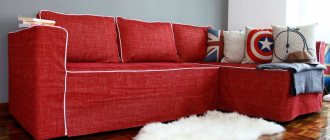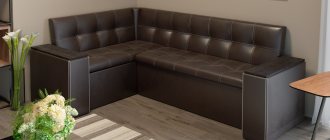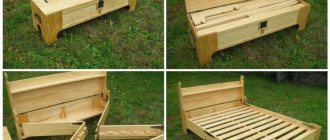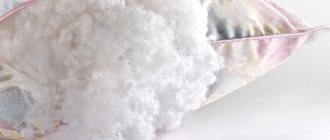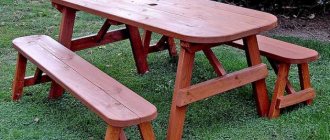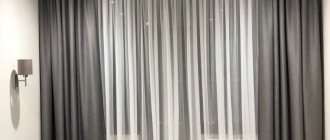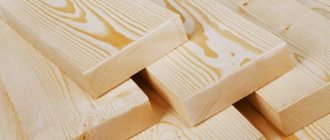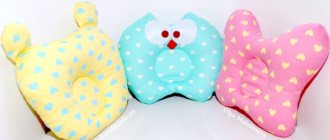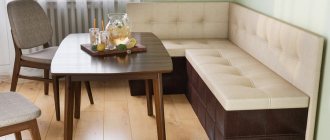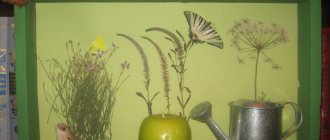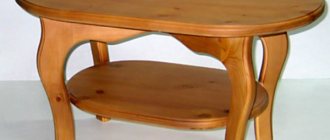How to sew a cover for a kitchen corner with your own hands
Statistics show that housewives spend half of their daytime in the kitchen. Cooking and setting the table is only a small part of the work process.
When everyone is happy and full, it's time to clean up. Stains are a popular consequence of cooking. If they do not scare the kitchen set and countertop, then the upholstered furniture requires extremely careful care.
The dining area with the kitchen corner is at risk, but there is salvation. A kitchen corner cover will be the best shield that protects furniture from unwanted dirt.
DIY kitchen corner cover
Kitchen corners come in different sizes and shapes.
It is not always possible to find a cover option that suits your kitchen. It's not scary, it's not difficult to create a cape yourself. Such a product will be in a single copy and will cost much less than having it made to order. Making a cover is easy if you have basic sewing skills. To create the simplest case you will need:
- upholstery;
- pattern material – muslin;
- several zippers or buttons to match the chosen design;
- special paper clips and pins for furniture;
- scissors, thread, needle and a piece of chalk (soap);
- decorative elements for decoration - ribbons, braid, plaits;
- sewing machine.
For the job to be successful, follow the step-by-step instructions, since the corner cover is created in parts:
At the first stage, the pattern, style and material are determined. The fabric must be washed, dried and ironed. This is necessary for the accuracy of measurements and to avoid shrinkage of the cover in the future. Using muslin, measure each part of the sofa: the main part, the side part, the armrests and the back part. Next, the patterns are sewn together
It is important to sew the parts together carefully. To avoid defects, the rough product is tried on a corner several times. Particular attention is paid to the places of folds and hems
The better you can hide the seams, the better the quality of the cover. If the pattern fits perfectly on the bench, the muslin is cut into pieces and tightly attached to the parts of the sofa. Then the elements are cut out from the material for the case. For durability of the product, connect the parts with dense threads. At this stage, fasteners and zippers are sewn in. The finished cover is tried on a corner and decorated if necessary.
Decorative elements for the cape are selected in accordance with the style of the interior. A stylish decor option is knitted details. If you know how to knit and crochet, feel free to start making them.
Eurocase
A variety of furniture cases is Eurocase. If you are good at cutting and sewing, you can create it yourself. This thing is made according to the same scheme as a regular case. The main difference between the product is the material.
The fabric is completely rubberized, which allows the case to fit the furniture perfectly. It does not need to be specially placed on a corner, the shape of the seat or back, or the presence of armrests does not matter - the cover will fit any design perfectly.
There are several types of fabric for the product:
- Jacquard is a combination of cotton, polyester and elastane. Thanks to thin elastic bands in the fabric, the cover stretches to the desired size. The material is not afraid of tightening and mechanical stress.
- Shinyl is based on acrylic and elastane. Products made from this material are light and pleasant to the touch. The case looks elegant and will decorate any interior.
- Pleating is a fabric with a springy texture that can withstand the claws of any animal. This case looks unusual and romantic.
- Microfiber is a light and weightless fabric that stretches better than others. Not only covers are made from it, but also furniture upholstery. The advantage of the material is its ability to quickly absorb moisture.
- Jersey is a dense and pleasant to the touch fabric.
Knitted products
You shouldn’t limit yourself to fabric alone when making covers for your kitchen corner. If you knit well, you can use a crochet hook or knitting needles to create interesting and unusual products. Knitted items fill the home with coziness, while each of them is individual. Therefore, if you do not belong to the category of people who consider “self-knitting” something unworthy and simple, you can safely start making it.
Of course, you need to consider the style of your kitchen. Knitted covers will not fit into high-tech or modern style, but country or Provence will decorate perfectly.
It is not necessary to completely tie the entire corner; you can tie a cape for the seat and/or back, and also decorate the sofa cushions.
What is a European case?
The sofa in the room is usually the central piece of furniture and it should look accordingly.
Until now, it was possible to give new life to upholstered furniture that had lost its appearance in three ways. The owners could:
- reupholster the sofa;
- sew the cover yourself;
- order tailoring of a cover from a specialized company.
Euro cover for sofa
The most popular way to revive old furniture was to install elastic covers on it. They are still common today. By the way, many sellers still pass off such models as fashionable European coatings.
Of course, it was possible to put a beautiful blanket or blanket on the damaged sofa, but this did not solve the problem. The most drastic way out of the situation was to purchase a new piece of furniture. The new European covers help protect newly purchased furniture from wear and tear and restore the attractive appearance of old sofas. With their help, you can easily make changes to the interior of the room if desired.
The cover will perfectly hide all existing imperfections
The main advantage of the products is their versatility. They are suitable for decorating any models of sofas: outdated designs and modern ones, home and office, with or without armrests.
What are the benefits of Eurocases:
- the covering can be stretched over sofas even of a non-standard configuration;
- they are very easy to put on furniture; even a not very athletic girl can complete the event alone;
- due to its structure, the material of the cover does not become dirty for a long time;
- The products can be washed simply in a washing machine (after numerous washes, the properties of the fabric are preserved); there is no need to iron them afterwards;
- it is possible to purchase a coating without visiting a retail outlet (on the Internet), since it is difficult to make a mistake with their model or size (a personal visit is recommended only to select the shade of the material);
- during use, the new upholstery does not deform, does not wrinkle, does not fade or stretch, there are no folds on it, it is highly resistant to wear;
- the fabric does not deteriorate from water and is antistatic;
- the material used in the manufacture of products is hypoallergenic, that is, people suffering from this scourge will not have problems with the skin or respiratory system upon contact with the fabric;
- covers last a long time (at least five years);
- thanks to its texture and coating, cat claws are not too scary, it is difficult to make holds on it;
- Manufacturers present many options for textures and colors of textiles, which allows you to choose the best option for any interior.
The disadvantage of the products, like any other types of capes, is that the furniture, which often has an interesting finish, is completely hidden under them. Of course, the cost of Euro covers is slightly higher than the prices for traditional models, but their functionality justifies the extra costs for upholstery.
If you're tired of your old sofa, you can update it by putting on a cover
What are they needed for
Many people find it inconvenient to cover a corner of the kitchen with a cover, and even more so in the kitchen. In small spaces, additional elements seem unnecessary. But the cover is guaranteed to preserve the appearance of the furniture. Neat and neat furniture is the first sign of order and cleanliness in the house. The cover is a mobile device that can be easily put on or taken off. Removable models help protect sofas, armchairs from soot and grease, as well as chairs. Dirt can cause inconvenience, as the upholstery is quite difficult to wash or clean. But with a cape there will be no such problems. It can be removed in no time and thrown into the washing machine. In addition to its standard purpose, a furniture cover helps refresh a boring interior. It will update the old kitchen corner and also transform the room.
Please note that when choosing a case you should pay attention to the material. The most practical options are eco-leather, vinyl and other washable materials. Fabric of natural origin is tactilely pleasant, but it quickly becomes dirty.
Colors
Expert opinion Maria Vasilievna Mikhailova Manager of a furniture store. Knows everything about comfort and interior design
In addition to the texture of the material, the choice of fabric colors is very important. If you plan to place furniture in a bright room, then it is better to choose a cover in pastel shades. A room decorated in these colors is perfect for relaxation.
If you need to make the decor more luxurious, combinations of classic contrasting shades such as white and chocolate will help. For large sofas, you should not buy fabrics with small patterns, and too bright an ornament on the color of the cover will be annoying.
Also, if you have to choose from several shades, it is worth turning to the psychological aspects of working with color, because the same color can have a completely different effect on the psyche, being several shades lighter or darker.
The selection of a shade of orange must be approached with special care. Experts do not recommend using orange as the main color when decorating a room or for large details in a room, because it has a stimulating effect on the nervous system.
Slightly washed out shades of orange or slightly darker than its pure color will look more advantageous.
A shade of green close to pastel evokes not always appropriate associations with hospitals and schools, however, it has a calming effect on the nervous system and promotes thought processes. Dark shades of color have a similar effect.
The difficulty in using dark green in room decor elements is that it is very difficult to choose suitable furniture colors for it.
The most optimal and multifaceted color that can formally be classified as green is light green. This is a very interesting shade, which includes the properties of the above-mentioned range and warm colors. Unlike light green, light green does not set you up for passive reflection, but for active knowledge of the world around you.
Light blue, blue or purple are suitable for the product if the sofa is the only (or almost the only) piece of furniture in the room. And if blue fabrics can still be safely used, then with an abundance of purple or blue you should be more careful, since these colors, as a rule, have a depressing effect and contribute to depression.
White color, according to experts, is relatively neutral in its effect on the psyche. Its indisputable advantage is that a sofa with a cover of this color will become an ideal “base” for further decoration of the room, and even the sofa itself. By adding pillows in bright colors, the furniture will be much more pleasing to the eye.
Black and gray colors, as well as blue and purple, should be used very sparingly, since the use of fabrics of these shades for accessories or just for sewing a cover can give the room a more stylish and strict look, or can make the room mournful and “oppressive.” The choice of brown color also needs to be approached carefully.
And you certainly shouldn’t use red material for sewing a cover, which is not smoothed out by softer colors, since red, even in comparison with other bright and rich colors, has a particularly strong effect on the nervous system.
Types of capes
Covers for the kitchen corner vary in style and main function: protection or decoration. According to these criteria, the following types of covers are distinguished:
- Glove model. This style fits the furniture quite tightly, so the cover fits like a glove. The option is called “working” because the cape is made of thick fabric. It is not afraid of moisture and is resistant to stains. Ideal for everyday use. It will be difficult to sew such a cover yourself, so it is better to seek help from a specialist. Then the corner will look stylish, high quality and expensive.
- Decorative model. The main purpose of the case is to decorate the product. Most often it is used for large feasts to protect furniture and give it an elegant look. The style of the cape can be anything, from a regular bedspread to a loose cover with ruffles. Sewing this option yourself is not difficult.
- Mixed model. This version of the case takes all the best from the previous two. You can use it every day and not worry about damaging your furniture. Plus the case looks beautiful and elegant.
The next important step is the choice of material. Give preference to practical materials that do not require special care. The cover should be easy to change, so keep the presence of decorative elements to a minimum.
The most common material for a kitchen corner cover is fabric with the addition of synthetics. It is easy to clean from dirt. There are a huge number of textures and colors, so the cape will fit perfectly into the interior.
A fur case will add exoticism to the interior. The option is bold and unusual. Even if you wish, it should not be used around the entire perimeter of the corner - it is better to cover the metal elements on the back or armrests for greater comfort. Fur pillows will also look elegant and cozy.
If the dining area has not only a corner, but also chairs, then fur covers can be made for them too: this will create a stylish tandem. This decor will fit perfectly into a Scandinavian style kitchen. It will not only add comfort, but also emphasize natural motifs in the interior.
Leather cases are rare. Usually, the material is used to sew capes on individual pieces of furniture - pillows or armrests. Skin textures vary in density. Coarser material is resistant to external influences, while fine material will add grace to the corner.
Warm and pleasant to the touch, suede is also used for kitchen furniture. For those who are uncomfortable sitting on a leather seat, this option is suitable. Suede goes well with leather, so you can create a combined case. The fabrics will fit perfectly into a modern-style kitchen and complement chrome and metal decor.
Covers made from yarn are particularly original. If you like to knit, then this option is for you. They are less practical, but have other advantages.
Most often, such a cape is made by the hands of the hostess, which indicates its uniqueness
This is a real designer decoration that will attract the attention of guests and refresh the interior. The product is ideal for a kitchen in Provence or country style. Oilcloth is considered the most reliable material for protecting furniture.
These covers are suitable for daily use as they are machine washable. They do not require ironing, drying, and do not lose color saturation. The only negative is its fragility. Oilcloth can be easily torn or cut
Oilcloth is considered the most reliable material in terms of protecting furniture. These covers are suitable for daily use as they are machine washable. They do not require ironing, drying, and do not lose color saturation. The only negative is its fragility. Oilcloth can be easily torn or cut.
How to put on the case
The elastic covering can be stretched over the sofa in a few minutes.
Included with the case, the manufacturer usually provides detailed instructions for fixing the product. The work technology includes several stages.
How to put on the case
Step 1.
The sofa moves away from the walls. It is necessary to provide access to all its elements.
Step 2.
The product removed from the packaging is laid out on the sofa.
The product is laid out on the sofa
Need to find a shortcut
Step 3.
The cover is put on the back, after which it is fixed on the armrest (you can start work from any side) and straightened out on it.
The cover is pulled onto the armrest
The fabric must be positioned correctly
Step 4.
The entire back of the sofa is closed.
The cover stretches over the back and second armrest
Step 5.
The covering is put on the second armrest.
Step 6.
The seams of the cover are tucked into the gap between the armrest and the seat.
The seams of the cover are tucked into the gap
Step 7
In the same way, the material is tucked into the recess between the back and the seat along its entire length.
The seams of the cover are tucked between the seat and backrest
Close-up photo
Step 8
The fabric on the second armrest is straightened and aligned in the same way.
The fabric is also tucked in on the first armrest
Step 9
The fabric is stretched to cover all visible parts of the piece of furniture.
The cover should hide the upholstery of the sofa
Step 10
To tighten the textiles in the central part, a special fixing tape is used, which is attached to the edge of the fabric (in the corner) and passed under the sofa.
Fixing tape
On the back side, the latch also clings to the cover with a clip.
Using a retainer
Step 11
In order for the material to be better fixed in the recess between the seat and the back, gaskets are used, which can be made of foamed polymer or corrugated cardboard folded into a triangular structure.
Spacers or holders for the recess between the seat and backrest
The holders are placed inside one at a time, tightly fixing the fabric. With the help of such simple devices, the cover will not crawl out of the cracks, even if the children are frolicking.
Using holders
Step 12
The covering is finally smoothed so that it exactly follows the contours of the sofa.
The cover is put on the sofa
Upholstered furniture has received a new look and will be able to delight owners with its attractive appearance for a long time.
The emergence of new technologies and materials makes it possible to extend the life of interior items without making special efforts to do so.
Chair covers
Preparing for work
First of all, you need to take care of the tools and fasteners. You don’t need anything particularly complicated, but it’s still better to take some nuances into account in advance so that you don’t have to run out of the kitchen for every item later. In addition to the standard set (scissors, tape measure, pencil, furniture stapler with staples No. 6), the following may be useful:
- glue;
- sandpaper, scraper or just a knife;
- plywood sheet;
- an Allen wrench or a Phillips screwdriver (depending on the type of bolts on which the sofa frame is assembled).
We reupholster the kitchen corner with our own hands
Remove all unstable and breakable objects away from the dining area - free up a springboard for your work. Be sure to cover the kitchen floor with film, as a lot of dust and dried glue can spill out. After this, remove the soft seats and backs from the frame that need to be re-stretched - we will continue to work with them.
If the kitchen sofa has several pillows of the same size, number their bases immediately. In most cases, a seat that is out of place does not align with the mounting points on the body.
Old upholstery fabric can be removed by simply pulling out the staples with a stapler (also known as an anti-stapler). After this, the foam rubber is removed, and the base itself is thoroughly cleaned of its residues and glue. At this stage, you also need to carefully examine the entire frame of the kitchen sofa, the hard elements of the seats and backs - they may need repairs or even partial replacement where the plywood is cracked. It is better to immediately sand and varnish scratched boards that are not hidden by upholstery so that they no longer spoil the appearance of the kitchen.
Types of textiles for the production of covers for corner models
Manufacturers sew covers from several types of fabrics (there are about ten of them). But the most in demand are seven types of products made from natural and synthetic fibers in different colors.
Jacquard
Made from 80% cotton (elastane and polyester are also added), the material has a high degree of stretch and excellent durability. The claws of pets will not cause much harm to such upholstery. This is facilitated by a very dense weave of threads. A three-dimensional image gives the textile an impressive appearance.
Jacquard
Shinil
This light but dense fabric, slightly reminiscent of plush material, greatly decorates the interior through the use of interesting patterns. The material is made from acrylic (the main type of thread), cotton and other fibers. The soft fleecy surface is dirt-repellent.
Shinil
Pleated
Textiles made from cotton and polyester look simple and a little rough, but this textured coating looks good on upholstered furniture. In addition, it is highly resistant to mechanical damage.
Pleated
Jersey
The fabric is made from elastane and polyester. It is medium-dense, soft, pleasant to the touch, has a smooth texture and has good wear resistance.
Jersey
Microfiber
The material stretches very well and tightly fits sofas of any configuration, giving upholstered furniture a luxurious look. The fabric is soft and cozy.
Microfiber
Eco leather
Such a covering would be appropriate at home, but eco-leather covers are especially in demand in office premises, as they have excellent anti-vandal qualities.
Eco leather
Flame retardant fabric
Those who care about home safety will appreciate covers that have the ability to prevent the spread of flames. The composition includes kanekalon fibers (75%) and polyester. The colors of the cases are mostly neutral.
Furniture fabric fire resistant
Not only are there quite a lot of fabric options used when sewing covers. The color palette of materials allows you to choose the optimal solution for any interior.
Fireproof fabric
Various types of coatings can be used to decorate furniture in interiors of various styles.
- Jacquard is perfect for covering furniture in classic settings.
- In rooms decorated in Art Nouveau style, it is appropriate to use covers from the Shinil series.
- The not very conspicuous pattern of pleated fabrics can fit into any interior. But such cases will look especially harmonious in modern designs: fusion, hi-tech, as well as in Scandinavian style.
The most convenient option
For those who are excellent at sewing, we can advise you to make such a high-quality item as a European cover. Its difference from other cases is, first of all, in the fabric from which it is sewn.
It is rubberized through and through, so the product made from it does not need to be specially placed on the corner, it fits it perfectly. Euro covers are not subject to the formation of folds or creases.
Expert opinion
Mikhailova Maria Vasilievna
Furniture store manager. Knows everything about comfort and interior design
It doesn’t matter either the shape of the backrest or the configuration of the armrests; the Eurocover will fit any design as needed. The fabric for this type of cover can be of several types.
- Jacquard - it consists of cotton, elastane and polyester. Thanks to the thin elastic woven into the fibers of the material, the cover can stretch to the size you need. The formation of puffs on the surface, including from cat or dog claws, is excluded.
- Shinyla - based on acrylic and elastane. Products made from chenille are very light, the elastic is located on the inside. Shinil looks elegant, has a plush texture and will decorate any interior.
- Pleating – corrugated texture, slightly springy. Pleated covers do not suffer from the effects of animal claws.
- Microfiber covers are the lightest and most weightless. Microfiber is a fabric that stretches better than all others. Not only can you sew covers from it, you can simply upholster furniture with it.
- The fantasy design in the form of folds will decorate any classic interior, as well as Provence style.
- An elegant solution would be to sew a cover from jersey, which is smooth and pleasant to the touch.
To learn how to update your kitchen corner, watch the following video.
The use of any materials without our prior written consent is prohibited.
Master class on sewing covers
You can sew the cover yourself if the housewife has the skills to work with a sewing machine. First you need to choose a fabric and decide on color and shape.
Sewing tools
How to measure a sofa correctly and make a pattern
After solving organizational issues, they begin to take measurements; how accurately and correctly they are taken will determine the final appearance of the cover. The sequence of actions is as follows.
- Conventionally divide the sofa into rectangular parts.
- To correctly determine the right and left sides of the ledge, to do this you need to stand facing the sofa.
- Measure the backrests, seat and armrests separately.
- Add and double the resulting parameters. For example, if the length of the long side of the sofa is 200 cm, the short side is 160 cm, then you will need 360 * 2 = 720 cm of fabric with a width of 150 cm.
You can simply draw a sofa on a piece of paper and transfer all the dimensions. Fabric should be purchased with a margin of 0.5-1.0 m, since in case of an error in the calculations it will be problematic to correct the situation.
Measuring the parameters of a sofa for a cover
How to make a pattern of a cover for a corner sofa
The next step will be to create a pattern, the sequence of actions is as follows.
- Make a pattern; for this it is better to use graph paper.
- Lay the fabric out on a flat, hard surface, pin the pattern onto the paper and trace it. You can use a dry bar of soap or chalk.
- Leave 1-2 cm for allowances and draw a second line along which to cut the material.
Cape pattern
Secure the pattern with safety pins
Features of sewing a cover
Sewing a product includes several stages.
Baste all the details from the wrong side; for this it is better to use a contrasting thread. Try the product on the sofa, at this time you can correct minor defects. Sew the parts from the wrong side, it is better to use non-woven tape, so the seam will be clearer and stronger
It is also important to choose the right thickness of the thread, since a thin one will constantly break. The machine stitch should not be frequent, it will destroy the fibers of the material. If the material is dense, it is better to duplicate the line again
To ensure that the cover stays on the sofa better, an additional elastic band is sewn along the free edge of the cover; it will secure the fabric under the seat frame or on the underside of the sofa. Remove basting. Iron the cover through a damp cloth.
All seams must be ironed correctly
Cut out new upholstery
The well-known proverb about the need to measure seven times and only then cut in the case of reupholstering a soft corner for the kitchen is more appropriate than ever. Moreover, you need to know some nuances on how to correctly measure and cut new upholstery. So, when working, follow these steps:
- Remove the old upholstery from the corner.
- Using a tape measure or measuring tape, measure all the parameters of the cuts - the width and height of the pieces of fabric. Make all measurements based on the maximum bend length.
- After the measurements have been taken and new material has been purchased, proceed directly to cutting. To do this, lay out the fabric in one layer, and place pieces of old upholstery on top of it. Trace the contours of the cuts on the new fabric with special chalk - this strip will be easily removed when wiping the fabric with a slightly damp cloth.
Important! It is also advisable to leave approximately 5 cm on each side for the hem of the fabric.
- If you have a plain fabric with a clearly defined pattern, then make sure that the pieces that will be located next to each other have a consistent pattern. Also, during the cutting process, determine the so-called share thread - the tension thread of the fabric. Make sure that in all areas of the material such a thread is located in the same direction, for example, everywhere in height or width.
Important! Incorrect calculation of fabric can reduce all the work to nothing and result in unnecessary expenses. Therefore, a novice craftsman needs to make the most accurate calculation of the material as follows: take any unnecessary old fabric on which to lay out pieces of old upholstery. After this, measure how long and wide you need a piece of new fabric.
Popular upholstery materials
Many different fabrics are used for furniture upholstery. But not all of them can be used for the restoration of chairs, stools or kitchen corners. The main selection criterion is practicality.
Textile
Traditionally, it is believed that synthetic fabrics are more suitable for the kitchen. This is due to the fact that they are not afraid of fluctuations in temperature and humidity. Synthetics are also easy to clean and wash. Just remember about fire safety! The sofa should not be close to the stove!
The ideal option is microfiber. Although this fabric is thin, it is very durable and resistant to mechanical stress. The Teflon-coated surface is not afraid of moisture, so it can be washed. Buyers will be pleasantly surprised by the wide range of colors.
We also advise you to take a closer look at the flock. This non-woven material is incredibly durable. He is not afraid of the claws of pets or sharp knives. The fabric tolerates temperature changes well.
The surface is treated with a water-repellent composition, which prevents liquids from penetrating into the furniture. The flock is pleasant to touch, it is soft and velvety. The advantages include low cost. The downside is that it absorbs odors.
Faux leather
The skin needs a certain level of moisture, which must be stable. She also does not tolerate heat well. Yes, and cleaning from dirt can only be done with special means. All this makes natural upholstery unsuitable for use in the kitchen, or will require frequent repairs of leather furniture.
But if you are completely satisfied with the appearance of this material, then why not choose a coating that imitates leather? Eco-leather or Arpatek look no worse. But they are much more practical and durable. Faux leather is easy to clean and costs less.
Now you know what to look for when choosing upholstery for kitchen corners. Enjoy the shopping!
Advantages of self-upholstery
For a novice home craftsman, reupholstering kitchen corners is not difficult. Simple design, availability of materials, simple manipulations simplify the process. Advantages of independent work:
- saving money without losing quality;
- acquiring a new skill (after wear and tear, restoration will be needed again);
- You can carry out repairs at any time;
- the opportunity to choose the materials yourself.
Companies offer calling a specialist to your home, taking measurements or removing furniture for subsequent restoration. All this is not cheap, and it takes a lot of time. Therefore, independence is more appropriate here.
A high-quality result cannot be achieved without disassembly, so you will have to spend time disassembling the structure and removing elements. This will allow you to change the coating without damaging other surfaces.
The owner independently assesses the condition of the structure. To strengthen it you will need fittings and suitable fasteners. To update the appearance of wooden panels, you will have to resort to using paint and varnish. To facilitate the process, tools and materials are prepared in advance.
Saving money without losing quality
Learning a new skill
You can make repairs at any time
Possibility to choose your own materials
Types of cases
There are several models of removable covers.
Eurocovers
Such products are suitable for any models of corner sofas. Your furniture can be modern or outdated, have rounded outlines or a strict shape with straight lines. The product can be left- or right-handed. The presence or absence of armrests also does not matter.
European are called stretch fabric products that take the shape of furniture due to elastic fabric. As a rule, these are dimensionless models with elastic. The color range is varied. Fabrics also vary. These are soft plush and waterproof wear-resistant materials.
So, the advantages of European covers are obvious.
- Versatility. Stretch products can be used for any sofa, including models with a shelf in the corner. There is no need to worry that the cape will not fit the size or shape of the furniture. The main thing is to know the approximate dimensions of the sofa.
- Ease of use. Anyone can put such a cover on furniture. No special skills are required for this
- Practicality. Typically, such products are made from fabrics that are resistant to abrasion, dirt, moisture, and mechanical stress (for example, pet claws). They serve for several years. Washing the fabric cover is easy. When compressed, the product fits easily into a medium-sized washing machine. Euro covers do not require ironing. After drying, they already have a decent appearance.
As for the shortcomings, there is only one. Even the most beautiful cover cannot compare with professional furniture reupholstery. The product can give a fresh look to a shabby sofa, hide stains on the upholstery, and change the color. However, if the furniture has original handles, the owners will no longer be able to admire them, since the cape will completely hide them.
Products that repeat the geometry of furniture
Such models also usually completely cover the sofa. On protruding parts they are fixed with an elastic band. However, as a rule, products of this type are made from inelastic fabrics
Therefore, when purchasing, it is important to check the size of the model. Only with full compliance will the fabric fit well on the sofa and be fixed freely, and will not bunch up
Sometimes elastic bands are replaced with decorative elements. They can be ribbons or ribbons. Often modern models are fastened with zippers. These options are very convenient. The clasp is completely invisible.
Capes for individual parts
Such products can represent various solutions. This can be a set of several parts that together cover the entire sofa. There are also products on sale that cover only the seat. This solution can be convenient if the furniture owner wants to save money or simply protect one seat from wear and stains. The advantages of such models are ease of washing. Individually, they take up very little space and can even fit into a small washing machine.
Range
The range of covers for upholstered furniture today is represented by the following options:
Eurocase
Covers of this type can be used to cover and protect furniture of any design; they are convenient to take off and put on. Such products are universal and suitable even for sofas with a shelf or bar. Used for sofas with a right or left projection.
Capes
This type of cover is not just an ordinary piece of fabric that can be placed on the sofa and then endlessly adjusted. Capes are also divided into several types:
- sets that are designed for each individual component of the sofa in the form of bedspreads,
- covers that follow the geometry of the sofa,
- sets, each element of which covers one part of the sofa.
With elastic band
Covers of this type are stretchable products; they must be well straightened before putting them on furniture. Otherwise, such products are very convenient to use, look extremely aesthetically pleasing and, due to their versatility, are suitable for sofas that have a protrusion on both the left and right and are essentially dimensionless.
Main varieties
The first type of style fits tightly and fits like a glove. This is more of a model for every day, which is made from practical fabric and is resistant to moisture and stains. This is the so-called working version, which is used in full all the time and is removed only on special occasions in order to demonstrate the beauty of the furniture. Sewing such a cover with your own hands without the skills is quite problematic. But if you order it to be made by a specialist, then, if it is sewn with high quality, it will look stylish and expensive.
The decorative cover has a completely different purpose. It is put on furniture when a large feast is expected and the owners are afraid that guests may inadvertently stain the upholstery of the upholstered furniture. As for the style, it can be loose tailoring or even just a cape or blanket like those used to cover furniture during repairs or before a long departure. You can sew such covers yourself.
There are also case options that combine the functions of both types. This is a case that is used every day, but made of beautiful fabric.
Features of choice
Since the corners can be of completely different sizes and configurations, it is best to sew the most suitable option yourself, because buying a Euro cover without armrests or ordering it from a designer can be much more expensive. And if you sew several copies, the furnishings in the kitchen can be changed by simply changing the cover and the rest of the textiles - towels, curtains, potholders and tablecloths.
Kitchen corner cushions
If the space and design of the room allows, then small pillows on kitchen furniture can become an original interior decoration. You can sew them yourself. This is not difficult to do even for a beginner.
Corner pads are made in different geometric shapes. They can be square, rectangular, round or cylinder-shaped. Pillows are stuffed with padding polyester or padding polyester. For products intended for seats, it is better to use foam rubber.
Owners often use pads as backrests and cushions for elbows, so it is recommended to use practical materials for their manufacture. They are often covered with a fabric that differs from the upholstery of the corner.
Decorative finishing
It is important not only to sew a cover or cape correctly, you also need to fit the product into the overall interior. The decor of the bedspread plays a big role in the design of the room. It has several options:
- Decorate the kitchen corner with pillows in different cases.
- They use ties in the form of plaits, ribbons, bows and lacing.
- Capes are decorated using ornaments made from different materials, which are applied to the central part of the product.
- The old cover will be updated with fringe or strands with tassels.
- Craftswomen often decorate textiles with knitted inserts, embroidery or macrame elements.
The main principle of such capes is practicality. The decor should not cause inconvenience or create discomfort.
Dimensions
Euro covers are variable in size. Due to the fact that the fabric stretches, the same product can fit furniture of different sizes. However, there are still boundaries. For example, large products are suitable for corner sofas measuring from 300 to 490 cm (including armrests). If desired, you can find a larger and more compact option.
Some manufacturers indicate exact parameters. For example, a product can be designed for a sofa with an armrest height of 30-40 cm, a seat width of 210-250 cm and 140-180 cm (long and short sides, respectively) and a seat depth of 70-85 cm. If fabric It doesn’t stretch at all, the parameters can be even more specific.
